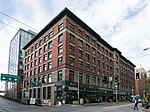The Penthouse (Seattle)

The Penthouse was a jazz club in Seattle, most remembered for John Coltrane's performance there in September 1965.The Penthouse opened in 1962 in Seattle's Pioneer Square neighborhood, founded by Charlie Puzzo. Over the next seven years, Puzzo presented such artists as Miles Davis, Bill Evans, The Montgomery Brothers, Stan Getz, Anita O’Day, Bill Cosby, Little Richard and Aretha Franklin. The club was on the ground floor of the Kenneth Hotel at 701 First Avenue, near the corner of Cherry Street, a building originally built as the Safe Deposit Building after the Great Seattle Fire of 1889, replacing the 1884 Merchant’s National Bank Building on the same site. Jim Wilke hosted Thursday night broadcasts from the club for KING radio.The saxophonist John Coltrane performed at the club September 30, 1965, with a sextet consisting of Coltrane on tenor and soprano saxophones, Pharoah Sanders on tenor saxophone, Donald Garrett on bass clarinet and double bass, McCoy Tyner on piano, Jimmy Garrison on double bass and Elvin Jones on drums. They were also joined on Afro-Blue by Joe Brazil and Carlos Ward and a third unidentified alto saxophonist and on another piece by an unidentified thumb pianist. Much of the session was issued 1971 in by Impulse! Records as Live in Seattle; other portions including Coltrane's last performance Billy Strayhorn's Lush Life appeared later on the album The Unissued Seattle Broadcast (RLR Records, 2011). See the Jim Wilke page for information on more recent releases from the 1960s material. The Penthouse closed in 1968; the building was demolished shortly thereafter, replaced by a multi-story parking lot.Seattle music historian Paul de Barros described The Penthouse, along with Pete's Poop Deck and Dave's Fifth Avenue as one of Seattle's "first true modern jazz clubs".
Excerpt from the Wikipedia article The Penthouse (Seattle) (License: CC BY-SA 3.0, Authors, Images).The Penthouse (Seattle)
Post Avenue, Seattle International District/Chinatown
Geographical coordinates (GPS) Address Nearby Places Show on map
Geographical coordinates (GPS)
| Latitude | Longitude |
|---|---|
| N 47.602723 ° | E -122.334786 ° |
Address
1st and Columbia Parking Garage
Post Avenue
98174 Seattle, International District/Chinatown
Washington, United States
Open on Google Maps








